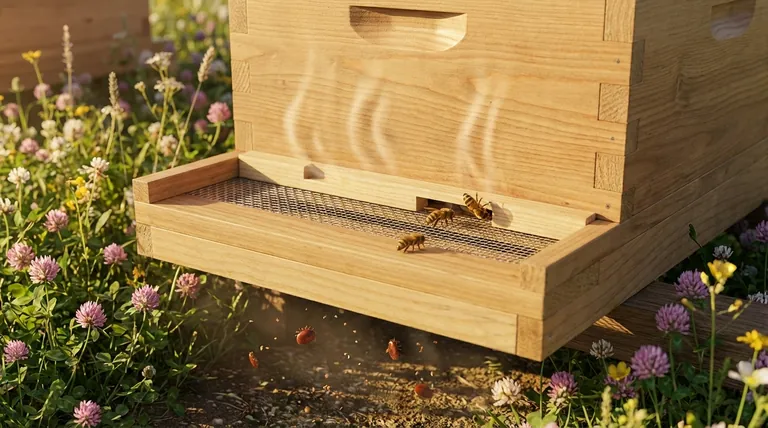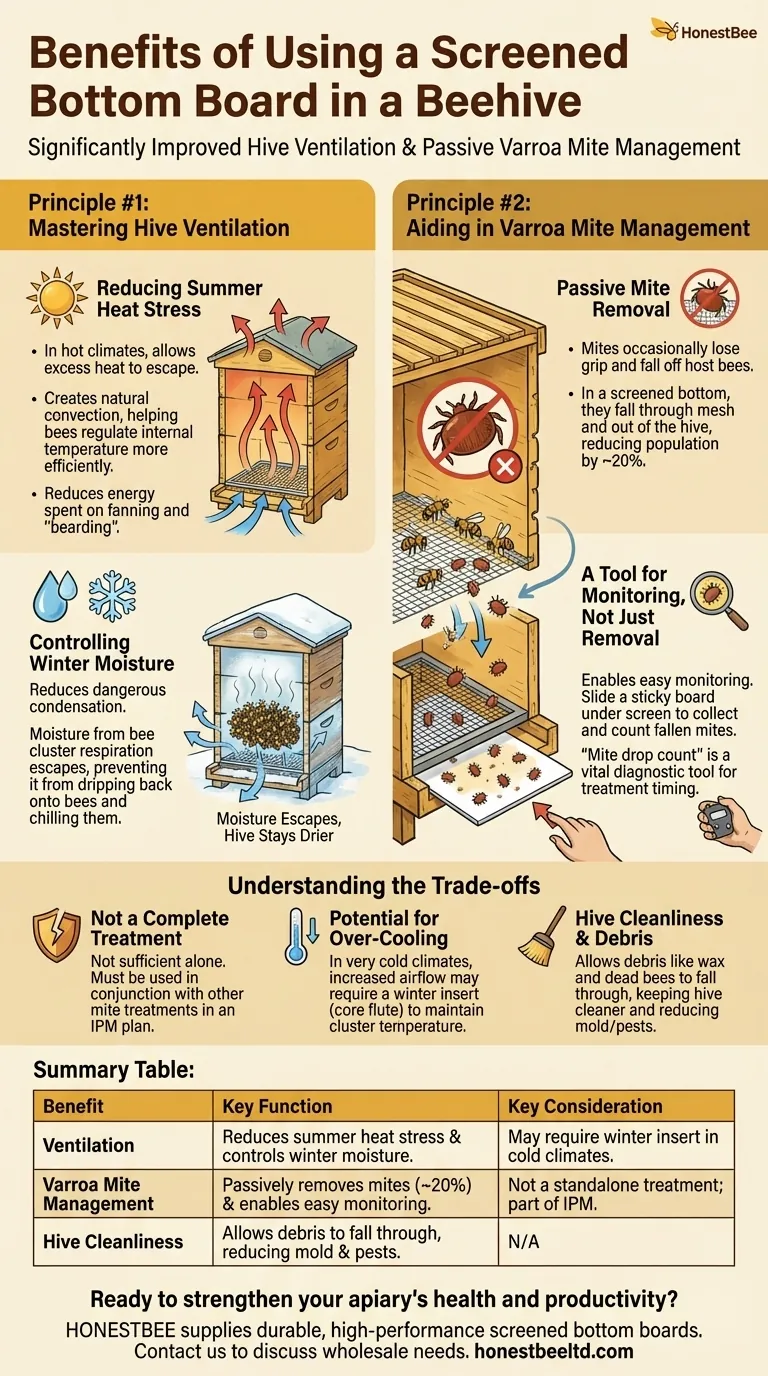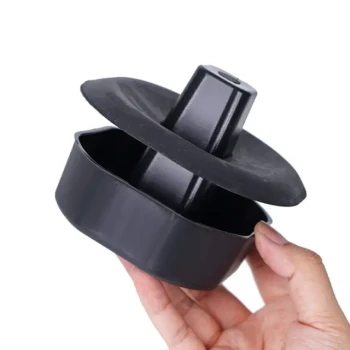The primary benefits of using a screened bottom board are significantly improved hive ventilation and a passive, non-chemical method for managing Varroa mites. This piece of equipment directly addresses two of the most critical factors in modern beekeeping: maintaining a stable internal hive environment and controlling the colony's most destructive pest.
A screened bottom board is best understood as a tool for environmental control. It gives the beekeeper more influence over in-hive temperature, moisture, and pest loads, which are crucial for maintaining a healthy, productive colony.

Principle #1: Mastering Hive Ventilation
Proper airflow is essential to a colony's health, and a screened bottom board provides a significant advantage over a solid floor in managing it.
Reducing Summer Heat Stress
In hot climates or during peak summer months, a colony can easily overheat. A screened bottom board allows excess heat to escape, creating natural convection that helps the bees regulate the hive's internal temperature more efficiently.
This reduces the energy the bees must expend on fanning and "bearding" at the entrance, freeing them up for foraging and other vital tasks.
Controlling Winter Moisture
Many beekeepers mistakenly believe that extreme cold is the biggest threat to a wintering colony. In reality, condensation is often the more significant danger.
As the bee cluster generates heat, moisture from their respiration rises. If it hits a cold inner cover, it condenses and can drip back down onto the bees, chilling and killing them.
A screened bottom board allows this moist air to escape the hive, keeping the interior drier and creating a healthier environment for the overwintering colony.
Principle #2: Aiding in Varroa Mite Management
The Varroa destructor mite is the single greatest threat to honey bee health worldwide. A screened bottom board is a key component of an Integrated Pest Management (IPM) strategy.
How Mites Are Passively Removed
Varroa mites occasionally lose their grip and fall off their honey bee hosts. In a hive with a solid bottom, the mite can simply wait for another bee to walk by and climb aboard.
With a screened bottom, many of these dislodged mites fall through the mesh and out of the hive entirely. This passive removal can reduce the overall mite population by an estimated 20%.
A Tool for Monitoring, Not Just Removal
Crucially, a screened bottom board allows for easy monitoring of mite levels. By sliding a white, sticky board under the screen for a set period (e.g., 24-72 hours), you can collect and count the fallen mites.
This "mite drop count" is a vital diagnostic tool that helps you determine when a more active treatment is necessary.
Understanding the Trade-offs
While highly beneficial, screened bottom boards are not without considerations. Understanding the trade-offs is key to using them effectively.
It Is Not a Complete Mite Treatment
A 20% reduction in Varroa mites is helpful, but it is not sufficient to control an infestation on its own. Relying solely on a screened bottom board will likely lead to colony collapse.
It must be used in conjunction with other mite treatments as part of a comprehensive management plan.
Potential for Over-Cooling
In very cold climates, the increased airflow can make it harder for the bees to maintain the cluster's temperature. This can cause the colony to consume more honey stores to generate heat.
Many beekeepers in northern regions use a removable insert (often a plastic or wooden "core flute") to close off the screen during the harshest parts of winter, converting it back to a solid floor temporarily.
Hive Cleanliness and Debris
The screen allows hive debris, such as wax cappings and dead bees, to fall through, which helps keep the hive cleaner. This reduces the house bees' workload and can help prevent the growth of mold or other pests attracted to the debris.
Making the Right Choice for Your Apiary
The decision to use a screened or solid bottom board depends on your climate and management goals.
- If your primary focus is managing Varroa mites with an integrated approach: A screened bottom board is an essential tool for passive mite reduction and critical monitoring.
- If you are beekeeping in a hot or humid climate: The superior ventilation from a screened board is almost a necessity to prevent overheating and control moisture.
- If you are in a very cold climate with harsh winters: A screened board with a removable insert offers the best of both worlds, providing summer ventilation and winter protection.
Ultimately, a screened bottom board provides a powerful and proactive tool for managing the health and environment of your colony.
Summary Table:
| Benefit | Key Function | Key Consideration |
|---|---|---|
| Ventilation | Reduces summer heat stress and controls winter moisture. | May require a winter insert in very cold climates to prevent over-cooling. |
| Varroa Mite Management | Passively removes mites (up to 20%) and enables easy monitoring via mite drop counts. | Not a standalone treatment; must be part of an Integrated Pest Management (IPM) plan. |
| Hive Cleanliness | Allows debris to fall through, reducing mold and pests. | N/A |
Ready to strengthen your apiary's health and productivity?
For commercial apiaries and beekeeping equipment distributors, the right equipment is the foundation of success. HONESTBEE supplies the durable, high-performance screened bottom boards and other essential beekeeping supplies you need to build a resilient operation.
Contact HONESTBEE today to discuss your wholesale needs and discover how our equipment supports superior hive management and sustainable beekeeping practices.
Visual Guide

Related Products
- Langstroth Screen Bottom Board for Beekeeping Wholesale
- Australian Pine Wood Langstroth Screen Bottom Board for Wholesale
- Langstroth Solid Bottom Board for Beekeeping
- Professional Insulated Winter Hive Wrap for Beekeeping
- Professional Galvanized Hive Strap with Secure Locking Buckle for Beekeeping
People Also Ask
- What are some considerations when choosing between solid and screened bottom boards? Optimize Hive Health & Pest Control
- What is the primary function of a screened bottom board in a hive? Enhance Ventilation & Control Varroa Mites
- How should the screened bottom board be used throughout the year? A Guide for Healthy Hives
- What are the benefits of using a screened bottom board for beehives? Improve Ventilation & Mite Control
- How does a screened bottom board assist with temperature control and pest management? A Key Tool for Modern Beekeeping



















